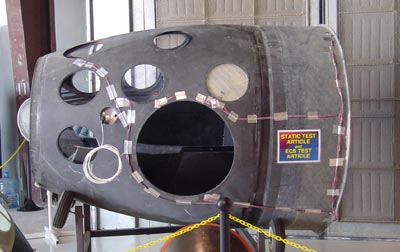|
|
 The need for a proper atmospheric pressure and mix of gases drives the design of spacecraft, like this SpaceShipOne passenger cabin test article. (credit: J. Foust) |
Human factors in commercial suborbital flight: what do I breathe, and why?
A small dose of pulmonary physiology
by John Jurist
Monday, March 7, 2005
The next few columns will deal with the spacecraft cabin and the design compromises that result from the way the lungs work. Then the problem of decompression, either emergency or planned, will be considered.
Everybody knows that air pressure decreases with increasing altitude, and effectively approaches zero in space. What does this imply for the spacecraft cabin designer and how does gas exchange in the human lung affect these design considerations?
For the cabin designer, less is better. There is a direct high correlation between cabin weight for a given volume and the pressure differential the cabin must withstand. The key variable here is the pressure differential between the inside of the cabin and the outside.
At launch, external or ambient pressure is one standard atmosphere at sea level (about 760 mm Hg), less if a high-altitude launch site is used. In space, the external pressure is effectively zero and the internal pressure is fixed by design. In order to minimize cabin weight, the designer will want to minimize internal cabin pressure while in space. However, the cabin occupants require some pressure in order to survive, so a necessary compromise must be reached. The cabin life support system will be designed to bleed cabin air during launch to equalize cabin pressure and ambient pressure up to a specified altitude. Above the critical altitude, the cabin will be sealed to maintain sufficient pressure to allow the occupants to survive—and, presumably, function.
Ordinary air is about 21 percent oxygen. As altitude increases and pressure decreases, the effective amount of available oxygen in the air, usually characterized by the partial pressure of oxygen, or pO2, decreases from a sea level value of 159 mm Hg (dry air) in rough proportion to total pressure.
| For the cabin designer, less is better. There is a direct high correlation between cabin weight for a given volume and the pressure differential the cabin must withstand. |
The situation inside the lungs is different. The gases in the lung (alveolar air) are saturated with water vapor. The partial pressure of water vapor in the lungs is roughly fixed at 47 mm Hg because of normal body temperature, and the other gases are proportionately distributed. The net result is that the available oxygen in the lung decreases disproportionately as altitude increases. For example, at sea level, the partial pressure of oxygen in the lungs (alveolar pO2) is about 103 mm Hg at a barometric pressure of 760 mm Hg. At an altitude of 6,000 meters, the barometric pressure is decreased by about 54 percent to 349 mm Hg, but the alveolar pO2 is decreased about 68 percent to 33 mm Hg. At about 19,000 meters, the barometric pressure is 47 mm Hg and there is theoretically no room in the lungs for oxygen.
Water vapor is not the only contribution to this problem. Assuming a constant metabolic rate and breathing activity at altitude, carbon dioxide plays a similar but lesser role than water vapor. For example, the amount of carbon dioxide in the lungs decreases from an average partial pressure of 40 mm Hg at sea level by about 25 percent to 30 mm Hg at 6,000 meters as air pressure decreases 54 percent.
The next column will discuss this issue and the engineering compromises that result.
John Jurist is a biophysicist with a long-standing interest in human factors. He currently resides in Billings, Montana and can be contacted at JMJSpace@aol.com. Any of the opinions expressed in these columns are his own and do not necessarily reflect the opinions or policies of XCOR Aerospace, Montana State University, or Santa Clara University.
|
|
